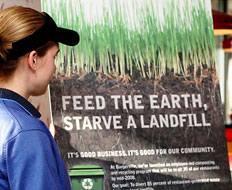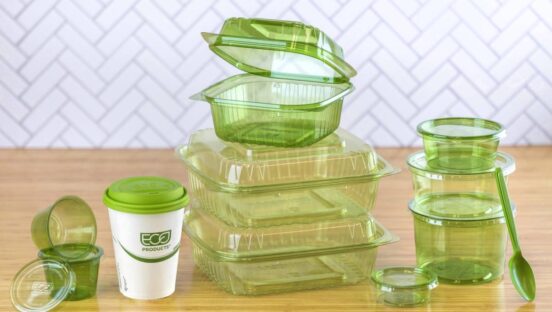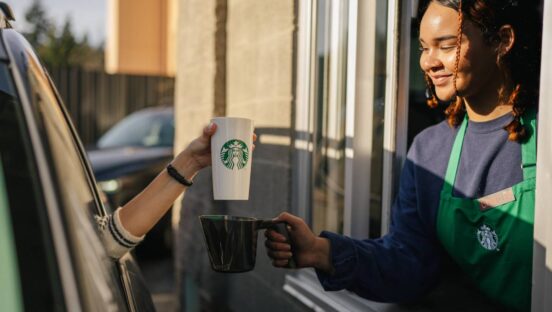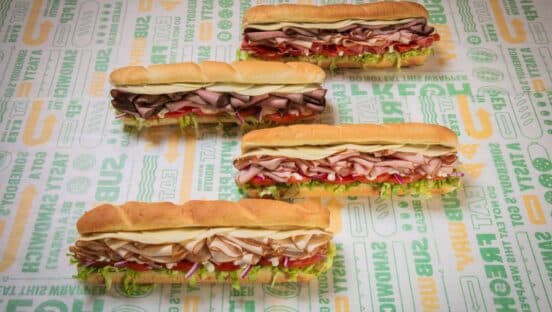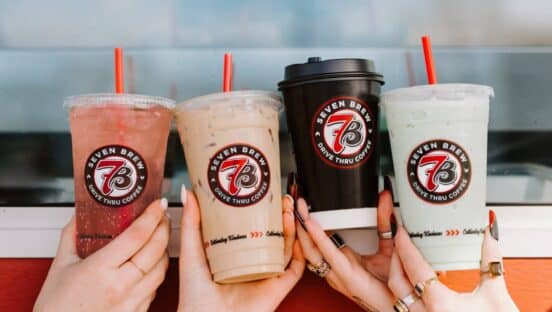When New York City–based burger concept 4food opened its first location in August, the media buzz it generated mostly stemmed from its innovative use of technology and social media. Plasma TV screens adorn its walls, including one that scrolls customer tweets. iPads are used to order food. And diners can save their specialized burger orders to an online database, available for anybody to order in the future—an act that credits the customer with 25 cents on later 4food visits.
But one of the most innovative features about 4food’s first unit isn’t wowing customers with its flashy technology. In fact, it’s in the basement’s washroom.
For the founders of 4food, it’s a critical component to an operation they hope to be as sustainable as possible—and a tool that might be a sign of things to come for a fast food industry that’s creating billions of pounds of waste annually.
The composting machine that 4food keeps in its basement disposes of all food and packaging waste the restaurant generates.
“It’s capable of composting up to 400 pounds of food waste and compostable packaging in a 24-hour period,” says Michael Shuman, cofounder and manager of 4food. “The amazing thing is, it runs on microorganisms, so it runs 24/7/365—we just feed it enzymes on a weekly basis.”
The product churned out by 4food’s composter, which is manufactured by a food disposal company called Orca Green, is just as interesting as the tool itself.
“It turns [waste] into drainage water,” Shuman says. “There’s no compost super sludge; this water just gets drained away.” The machine will also compost the waste from 4food’s next four or five locations as well.
4food’s solution to diverting its waste from landfills is a bright idea in an industry desperate to figure out what to do about waste. Although a composting machine like 4food’s is a capital investment not every operator can afford, some experts say just sticking to the status quo is ultimately too harmful to the environment—and to an operation’s bottom line.
Michael Oshman, president of the Green Restaurant Association (GRA), says waste in the restaurant industry has become a major issue—so major, in fact, that the GRA lists “Waste Reduction and Recycling” as one of its seven Green Restaurant Certification Standards.
“Restaurants can easily put out a few hundred thousand pounds of waste every year,” Oshman says. “And that’s one restaurant. Multiply that by almost a million, and you get a lot.”
Making the transition to a system that reduces waste sent to a landfill, however, is not one that a lot of operators feel they can make, especially in a down economy.
“Restaurants have a very tight margin and operate at a very quick pace,” says Jack Macy, commercial zero waste coordinator for San Francisco’s Department of the Environment. “There’s a perception that if it’s a lot more work, they’re not going to want to do it without really big incentives. The reality is it doesn’t have to be more work at all. … But to get people’s attention, it always helps to have incentives.”
And indeed there are incentives for restaurants to begin reducing the waste they send to landfills. The GRA, for example, awards a Green Restaurant Certification to restaurants that accumulate at least 100 points in the organization’s point system. In the “Waste Reduction and Recycling” category, restaurants are required to divert plastics, glass, aluminum, cardboard, and paper from landfills; recycle grease for biodiesel or energy purposes; and compost preconsumer food, the food that is leftover from production.
Those actions earn a restaurant 40 points. Several other waste-reducing efforts, such as postconsumer food composting, can earn a restaurant many more points.
The Climate Action Reserve, like the GRA, is attempting to provide incentives to restaurants to become more sustainable and reduce waste. The organization recently rolled out its Organic Waste Composting Project Protocol, which offers guidelines for developing carbon offset projects and generating offset credits through composting. The credits can then be traded in the carbon market.
“When we set out to look at food waste as a source of emissions of greenhouse gases, we discovered that only 2.5 percent of food waste is diverted to compost facilities,” says Gary Gero, president of the Climate Action Reserve. “Food waste that goes into a landfill generates methane because it’s anaerobically digested there, and methane is 21 times more potent than CO2 as a greenhouse gas.
“Having 97.5 percent of all food waste end up in a landfill is a tremendous detriment to the environment and impact on climate change.”
Packaging waste, too, is a detriment to the environment—not because it degrades into harmful gases, but because it hardly degrades at all.
“Plastics don’t degrade, they’re sitting [in a landfill] for a thousand years,” says Heeral Bhalala, lead coordinator for the Sustainable Biomaterials Collaborative and program associate on the Waste to Wealth program for the Institute for Local Self-Reliance. “We use it for five minutes to quickly chomp down our food, and then it’s sitting there … for a thousand years.”
With food and packaging waste posing such a dangerous problem to the environment, some quick-serve operations, like 4food, are fighting back. By implementing recycling and composting programs, quick serves are turning the path of waste away from the landfill.
Baja Fresh is one such operation. In December 2009, the company introduced an eight-store test of its “Earth Fresh” program, which rolled out recycled napkins, recycled paper bags, recyclable burrito wrapping paper, and biodegradable plates to the restaurants. The company since has set forth plans to take “Earth Fresh” systemwide, with total implementation expected by January 2011.
[pagebreak]
Having packaging like biodegradable plates that can be composted without harming a landfill helps operators who do not wish to have separate sorting containers in the front of the house.
“One of the things we recognized when we wrote our standards was that facilities tend to get food mixed with soiled paper products,” Gero says. “When we studied it, we determined that, in fact, it was fine to have the soiled paper products as part of the compost pile. That really opens the opportunity for particularly fast food facilities to use the program, given that it’s so difficult to separate the packaging and the food waste.”
Macy says front-of-the-house bins pose a challenge for quick serves interested in diverting waste to the recycling or composting streams because they require help from the consumer. But, in a city like San Francisco—where regulations require that foodservice ware be recyclable or compostable, and where the composting infrastructure is extensive—brands have used the bins as an extra branding effort.
“In the city of San Francisco, when you get these chains like McDonald’s, Burger King, or Starbucks, each of them wanted to create their own customized signage and bins,” he says. “Instead of having just one trash bin now in the public area, you have three: you’ve got a bin for all of the compostables, a bin for all of the recyclables, and one for what’s left over, and that’s trash. There is really cool, customized signage, and there’s the whole branding that goes along with that.
“It’s like, ‘Wow, it’s not just this mindless throwing stuff away. There’s really environmentally responsible model of what can be done.’ It’s really refreshing and exciting to see that.”
With food waste, not every quick serve can afford a solution like 4food’s composting machine, which costs around $20,000. But operators still have options.
“Maybe a small portion of that might be edible food, and there’s an opportunity to redistribute that to organizations that collect and feed the hungry,” Macy says.
In fact, restaurants have many opportunities available to them to donate leftover food. The Food Donation Connection organization, for example, works in conjunction with the National Restaurant Association to collect surplus food from restaurant operators and donate it to food agencies.
But, Macy says, “the biggest opportunity is to take all of that material that can be composted or degraded biologically and to compost it.”
Macy says composted food is an incredibly valuable resource since it contains nutrients and organic matter. “By composting it and returning that organic matter to nutrients in the soil, we really are doing what we need to do, which is to feed our depleted soils so that we can sustain the growing of food,” he says.
A composting system, however, takes a sizable amount of upfront effort to implement. GRA president Oshman says that when working with restaurants to help them reduce waste, the GRA will first assess what a restaurant’s waste hauling program looks like, then contact waste haulers and property managers to find out what kind of resources are available in that particular area, then discuss logistics with a property manager, and finally make a switch to new waste-hauling practices.
After making the upfront investment on a recycling and composting program, Oshman says restaurateurs will eventually make a return on that investment.
He says a cost called the tipping fee that truckers pay at the landfill when they dump garbage is an expense that the restaurateurs indirectly pay and can avoid when using a composting program.
“Replace that truck of garbage with cardboard or aluminum, however, and it is a much different case. “Guess what? You’re selling that,” Oshman says. “You dump it and somebody’s going to pay you. You’re making money there.”
Jack Graves, chief cultural officer for Pacific Northwest–based Burgerville, says that a composting or recycling program will ultimately pay for itself. At Burgerville, which implemented an employee-led composting and recycling program in 2007, the company saves more than $129,000 each year on its packaging efforts, and each unit saves $80,000 per year by switching from landfill hauling to recycling and composting.
“We are able to offset the cost of compostable materials with the reduction in tipping fees,” Graves says.
Charles Rink, president of Baja Fresh, says working with suppliers to obtain more compostable and recyclable packaging materials is also a good financial move during the recession.
“In some ways it’s actually a positive, because there are people out there on the supply side who are willing to work with you to try and come up with a solution, whereas maybe in the past they had such a strong business demand that they really didn’t have time to work on options of this nature,” he says. “Today it seems like they’re a much more willing group to work with.”
And not only is waste reduction a smart financial move, but more consumers are demanding sustainable options.
According to the “Consumer’s Green Dining Habits” study released by Technomic in May, 87 percent of consumers said they expected a green restaurant to recycle. Further, 79 percent of consumers said they would more likely visit a Certified Green Restaurant than a non-Certified Green Restaurant.
“[Reducing waste is] one of the biggest things they can do to reduce their carbon footprint and become more green, and I think a lot of people want to do the right thing,” Macy says. “And that’s certainly appealing to customers.”

